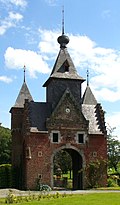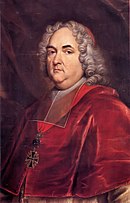Teutonic Order Biesen
The Ballei Biesen of the Teutonic Order was an administrative area that extended over what is now Belgium , the southern Netherlands and the Lower Rhine . Their seat, Alden Biesen Castle near Tongeren north of Liège , is still preserved today.
history
Between 1228 and 1270, the Ballei Biesen was run together with the Ballei Utrecht by a Landkomtur in personal union. From the Ballei, more than twelve subordinate land committees, lordships and formulas as well as parishes and theological educational institutions in the Rhine-Maas area were administered in some cases. From 1317 at the latest, Biesen was its own ballot, which at that time already had a priority position in the Teutonic Order because it had an above-average amount of real estate in comparison to the other Teutonic Order branches in the region.
The coming of the Teutonic Order, which represented the monasteries of the knights and priests , were grouped together in larger associations. These associations were called balleien and can be compared with religious provinces . At their head was a land commander , who can be compared with a provincial in other orders .
Coming of the Ballei
In addition to the commendants listed below, there were also numerous parishes that were incorporated into the Ballei (Gemert, Vught, Nistelrode, Handel, Bakel, Gelsdorp, Gruitrode, Bekkevoort, Ordingen, Beek, Vroeghoven, Welz, Lüttich). The Ballei also maintained a seminary at the University of Leuven , a grammar school in Gemert and various student grants and a study center in Cologne . The following, who were only subject to the Biesen for a short time or temporarily, included:
- Coming Welheim , Archdiocese of Cologne ; Date of foundation unknown, incorporated into the Deutschordensballei Westfalen around 1300
- Coming Dieren, diocese of Utrecht , founded around 1218; initially belonging to the Kammerballei Koblenz , it was pledged to the Ballei Biesen in 1420; 1434 resold by the Ballei Utrecht
- Upcoming Mechelen-Pitsemburg, Diocese of Cambrai , attested from 1269, incorporated into the Koblenz Chamber of Commerce after 1300.
| Coming | from | to | annotation | image |
|---|---|---|---|---|
| Upcoming Alden Tucks | around 1220 | 1797 | Diocese of Liège ; The name Alden Biesen was created in 1361 after Nieuwen Biesen was founded. Seat of the Landkomtur until the middle of the 14th century, then again from 1620. In 1797 it was secularized by the French and auctioned. |

|
| Upcoming Aschaffenburg | 1749 | 1773 | Archdiocese of Mainz ; previously owned by the Deutschordensballei Hessen ; Run down by financial manipulation, Grand Duke Karl Theodor von Dalberg had a theater built in Kronberger Hof in 1811 and included the German House |

|
| Upcoming Bekkevoort | 1280 | 1796 | Diocese of Liege, devastated in 1578, 1585 the seat of the commander after was Diest moved |

|
| Upcoming Bernissem | 1237 | before 1793 | Diocese of Liège; owned, among other things, the patronage of the church of Montenaken , went bankrupt before 1793 |

|
| Upcoming jellies | around 1247 | after 1400 | Diocese of Liège; attested as coming from 1247 to 1341, no more mentions from 1400 onwards | |
| Immediate imperial rule and the coming of Gemert | before 1249 | 1797 | Diocese of Liège; The time of foundation unclear, around 1249 the 2nd Commander-in-Law can be found; Until 1668 existence not continuously verifiable, then secured rule over the glory of Gemert |

|
| Reign and Coming Gruitrode | 1416 | 1801 | Diocese of Liège; from 1417 parish rights; 1568 New building of the commander after the war devastation of 1483 |

|
| Recipe Holt | 1281 | 1611 | Diocese of Liège; Little Coming of the Ballei; 1611 transferred to the coming orders | |
| Coming boys tucks | 1573 | 1802 | Archdiocese of Cologne, location in Cologne in the area of Severinstrasse in the immediate vicinity of the Kommende St. Katharina of the Koblenz Chamber of Commerce |

|
| Upcoming Liège (St. André) | 1255 | 1795 | Diocese of Liège; Richest comedian of the Ballei; Seat of the prior of the Ballei Biesen; between 1634 and 1657 new construction of the command building; | |
| Coming new tucks | between 1358 and 1361 | 1794 | Diocese of Liège; located in Maastricht , priestly convent, novitiate house; From the middle of the 14th century until 1620 the seat of the provincial commander and until the middle of the 18th century of the chapter of the ball | |
| Reign and coming orders | 1611 | before 1800 | Diocese of Liège; was also taken over by Kommende Holt when it was founded |

|
| Lordship and Coming of Ramersdorf | 1230 | 1803 | Archdiocese of Cologne; first German mastery, not transferred to the Biesen ballot until 1371 |

|
| Teutonic order in Siersdorf | 1219 | 1809 | Archdiocese of Cologne, 1578 new building after being destroyed during the war; |

|
| Teutonic Order Coming St. Aegidius | 1321 | 1802 | Diocese of Liège; Pontstrasse in Aachen ; up to the 16th century. |

|
| Immediate imperial rule and Coming Sint-Pieters-Voeren | 1244 | 1798 | Diocese of Liège; the old buildings were replaced by a new palace complex in the 17th century |

|
| Sint Truiden recipe | 1254 | before 1800 | Diocese of Liège; | |
| Vught recipe | 1483 (not used) | before 1800 | Diocese of Liège; first mention of a commander around 1373; took over the patronage right over the St. Lambertus Church |

|
Land Commander of the Ballei Biesen
- Henricus around 1229/30
- Henricus around 1235/8
- Ludwig around 1240/1
- Wilhelm around 1250/2
- Walther von Koblenz approx. 1253
- Diederik Guldenhoofd approx. 1255 – approx. 1267
- Gerard van Printhagen approx. 1265–1267
- Lodewijk van Kinswilre approx. 1267/8
- Nicolaas van Horne approx. 1268/70
- Mathias van Franchevort 1270-1271 / 2
- Herman van Rijkel 1271/2 - approx. 1275
- Nicolaas van Horne approx. 1275 – c. 1280
- Ecbertus van Stockheim approx. 1282–1284
- Dierik van der Horst 1284 – approx. 1290
- Dierik van Wevelhoven approx. 1290 – approx. 1295
- Walter van Papenhoven approx. 1300–1307
- Dierik of Holland 1307-1317
- Gerard van Loon 1317-1324
- Rutger van Kaldenberg 1324-1327 / 8
- Johan van Hoenhorst 1327/8 - approx. 1338
- Hendrik von Hindenburg around 1338
- Gerard van Printhagen around 1339
- Dierik (or Hendrik) van Rondorp around 1340
- Wynand van Spanbeke about 1343
- Konrad van der Kaulen approx. 1345–8
- Konrad van Vranckevort approx. 1349–50
- Rutger van Vriemersheim 1353-1358
- Renier Hoen van Hoensbroek 1358-1371
- Hendrik van Leeuwenberg 1371 – approx. 1380
- Renier van Hansen approx. 1380–1410 / 1
- Ivan van Cortenbach 1410/1-1434
- Dierik van Betgenhusen 1434-1440
- Albrecht von Fortsche von Thornauw (Lieut.) Approx. 1440/3
- Mathias van der Straten 1444-1460
- Nicolaas van der Dusen 1460–1467
- Johan van de Velde 1467–1481
- Gerard de Sombreffe 1481-1482
- Johan van Herck 1482-1503
- Maximiliaan van Eynatten 1504-1512
- Gerard van Streithagen 1512–1536
- Wynand van Breyll 1536–1554
- Jan van Goer 1554-1572
- Heinrich von Reuschenberg zu Setterich 1572–1603
- Willem Frambach Bock van Lichtenberg 1603-1605
- Edmond Huyn van Amstenraedt 1605–1634
- Godfried Huyn van Amstenraedt van Geleen 1634–1657
- Edmond Godfried von Bocholz 1657–1690
- Hendrik van Wassenaer dead Warmond 1690–1707
- Damian Hugo von Schönborn 1707–1743
- Ferdinand Damian von Sickingen 1743–1749
- Wiric Leopold von Steinen 1749–1766
- Kaspar Anton von der Heyden 1766–1784
- Franz Johan von Reischach 1784–1807
Knight (DOR) and priest (DOP) of the Ballei Biesen
A.
- Edmond Huyn van Amstenrade (DOR)
B.
- Caspar Anton von Belderbusch (DOR)
- Henricus De Bije (DOP)
- Edmond Godfried von Bocholtz (DOR)
- Winand von Breill (DOR)
C.
- Johan Coolen (DOP)
- Iwan von Cortenbach (DOR)
- Willem Frans Cox (DOP)
- Theodor de Croix (DOR)
- Michael van den Cruys (DOP)
D.
- Petrus Adam Nicolaas Daemen (DOP)
- Heinrich-Johann von Droste zu Hülshoff (Councilor, DOR)
F.
- Herman Fabritius (DOP)
- Johan Jacob Frissen (DOP)
G
- Gottfried Huyn von Geleen (DOR)
- Johann von Goer (DOR)
H
- Henricus Haling (DOP)
- Adam of Holtorp (DOR)
L.
- Robert Laurent Christophe Lintermans (DOP)
M.
- Georgius Morberius (DOP)
N
- Wilhelm von Neuhoff (DOR)
R.
- Franz von Reischach (DOR)
- Conrad von Reuschenberg (DOR)
- Dietrich Stefan von Reuschenberg zu Selikum (DOR)
- Edmund von Reuschenberg zu Overbach (DOR)
- Franz von Reuschenberg zu Setterich (DOR)
- Johann Heinrich von Reuschenberg zu Setterich (DOR)
- Johann von Reuschenberg zu Selikum (DOR)
- Johannes Ernst Freiherr von Reuschenberg zu Setterich (DOR)
- Wilhelm Constantin von Reuschenberg zu Selikum (DOR) - resigned during the probationary period
- Franciscus Rudolphi (DOP)
S.
- Damian Hugo von Schönborn (DOR)
- Ferdinand Damian von Sickingen (DOR)
T
- Petrus Frans Theunissen (DOP)
V
- Paul Willem van Vuecht
W.
- Hendrik van Wassenaar (DOR)
literature
- Leden van de Duitse Orde in de Balije Biesen. Historically Study Center Alden Biesen, Bilzen 1994.
- Inventory of the archief van de balije Biesen van de Duitse Orde, vol. 2, ed. v. Michel Van der Eycken (Bijdragen tot de geschiedenis van de Duitse Orde in de balije Biesen 3b), Bilzen 1996.
- Militzer, Klaus: The History of the Teutonic Order, Stuttgart 2005.







